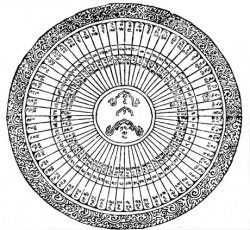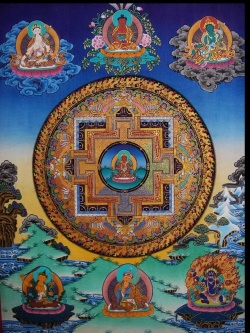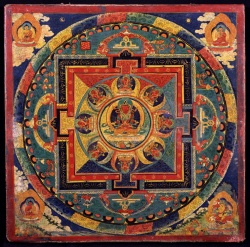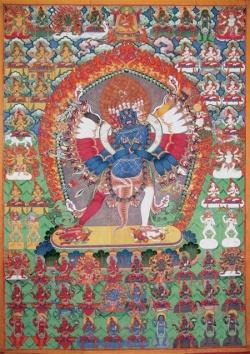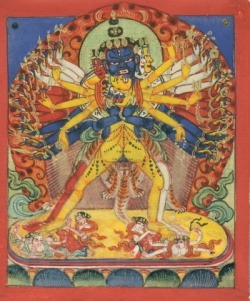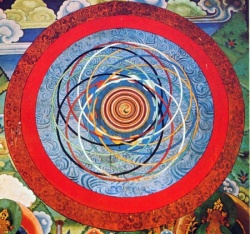Intercalary months in the Kālacakra and Tibetan calendars
One aspect of Tibetan calendars that has caused problems both for Tibetan calendar makers and later analysts is the determination of intercalary months.
Because the length of the mean lunar month (tshes zla) is less than the length of the mean solar or zodiacal month (khyim zla), in order for the months to stay in step with the seasons, just over every two and a half years, an extra, or intercalary, month (zla shol, zla ba lhag pa) is required.
For the original Kālacakra calendar, an approximate relationship is used to determine which months are intercalary, but as this is approximate, it only holds for about 40 years and then has to be reset.
Each month in this system is named after the zodiac sign that the Sun enters during the month, and the definition of an intercalary month is one in which the Sun does not change zodiac sign. Of course this can be determined simply by inspecting the numbers once a calendar has been calculated. The approximate relationship used is that 67 mean lunar months = 65 mean solar months.
The calculation used is straightforward.
The number of years since the epoch is multiplied by 12 to yield zodiacal months, and then any additional months are added as required.
This number of zodiacal months is then multiplied by 1 2⁄65. This converts the count of solar months to a count of (shorter) lunar months. When the fractional part carries over, this indicates an intercalary month, one during which the Sun does not change sign. This calculation will be demonstrated later.
In the description of the Kālacakra calendar as given in the Vimalaprabhā, we are told that the calendar needs to be adjusted in the light of observation.
In particular, the longitude of the Sun has to be corrected, by means of detemining the time of winter solstice, when the longitude will be set to 0° Capricorn (20;15 in lunar mansions and nāḍī).
It follows that the conversion of zodiacal into lunar months and the check for intercalaries would also need to be adjusted.
In the description that follows, bear in mind that the principles in later Tibetan calendars are basically the same as with the Kālacakra system, but in the Kālacakra the 67:65 relationship is an approximation, whereas in the later Tibetan calendars, it is mistakenly taken as precise.
Tibetan calendar makers such as Phugpa Norzang Gyatso (phug pa nor bzang rgya mtsho) and Zhonnu Pal gzhon nu dpal) came to the view that they could construct a perfectly accurate calendar in which the longitude of the Sun would not need correction.
They took the relationship of 67 mean lunar months = 65 mean solar months to be exact, and from this determined a new mean change of longitude of the Sun each lunar month. This introduced significant error in their calculations.
At the same time, they took a relationship given in the Kālacakra Tantra for converting lunar days into solar days, and used this to create a new figure for the mean length of a lunar month in terms of solar days – this actually produced a small improvement in the accuracy of that particular relationship.
One effect of this was to create a repeating structure to the calendar, which must have been very compelling. Exactly the same 24 intercalary months repeat every 65 years.
The numbers used in the zodiacal to lunar month conversion have meanings that can be clearly defined. The calculation is done by writing the zodiacal month number in two places.
The lower is multiplied by 2, and then divided by 65.
The quotient from this division is then added to the top line, the result being the number of lunar months.
Take as an example, 101. This means that we are calculating for a new Moon, 101 zodiacal months after an epoch:
- 101 + 3 = 104
- 101 x 2 = 202 ÷ 65 = 3 rem. 7
This tells us that 104 lunar months have elapsed since the epoch.
The remainder of 7 can be called the intercalation index.
There is one thing missing from this – usually there will be a similar remainder (rtsis 'phro) when the equivalent calculation is performed for the epoch, from some previous epoch. This remainder would also need to be added in here. Take as an example a previous remainder from the epoch of 16, and the calculation becomes:
- 101 + 3 = 104
- 101 x 2 + 16 = 218 ÷ 65 = 3 rem. 23
| 32 1⁄2 months: It will be noticed that an intercalary month is followed by |
Tsuglag Threngwa(gtsug lag 'phreng ba) tells us that the division on the bottom line should really be by 32 1⁄2 – an intercalary month is followed by the next after 32 1⁄2 months.
But because this kind of arithmetic cannot handle halves (or other fractions), he says that the bottom line value is multiplied by two and then divided by 65 (twice 32 1⁄2 months).
The Kālacakra Tantra takes this one step further, and the bottom line is multiplied by four, and then divided by 130. Our calculation would become:
101 + 3 = 104 101 x 4 + 32 = 436 ÷ 130 = 3 rem. 46
The result is still the same. An intercalary month is identified when the quotient on the bottom line increases by one, and the remainder (dividing by 65) is either 0 or 1. As an example, take the two months calculating for 97 and 98 zodiacal months, and ignoring any previous epoch remainder:
97 + 2 = 99
97 x 2 = 194 ÷ 65 = 2 rem. 64
98 + 3 = 101 98 x 2 = 196 ÷ 65 = 3 rem. 1
Notice that with an increase of just one zodiacal month, the count of lunar months has increased by two. The month that falls between these two is the intercalary; considering the three months that are respectively 99, 100 and 101 lunar months after the epoch, the middle one is intercalary, and in the original Kālacakra tradition would be considered to be a repeat of the month before. A couple of years later, the calculation would yield the next intercalary:
129 + 3 = 132
129 x 2 = 258 ÷ 65 = 3 rem. 63
130 + 4 = 134 130 x 2 = 260 ÷ 65 = 4 rem. 0
This tells us that the lunar month that is 133 months after the epoch is an intercalary.
Notice that for the first intercalary described here (after 100 months) the remainder on the bottom line of the calculation when the month count increases is 1; for the next intercalary (after 133 months) that remainder is 0.
These remainders alternate, and when such a remainder of 0 or 1 occurs in the calculation, this indicates an intercalary month. Of course, in the Kālacakra way of doing things (dividing by 130 instead of 65), this remainder would have the values 0 or 2.
Tibetan writers often mention that the calculation for an intercalary arrives either at the end of the month, or in the middle; of course, an intercalary month has to be a whole month, nothing else, so just what is intended here? The answer to this lies in the point made by Tsuglag Threngwa that the division on the bottom line should really be by 32 1⁄2.
This is just a mathematical curiosity – all intercalary months are the same.
For each one, just before the new Moon at the beginning of the month, the Sun enters a new zodiac sign, and immediately after the new Moon at the end of the month, the Sun enters the next sign.
The concept of the calculation taking us to the middle or end of the months depends on just where the counting is considered to start, and is best explained by the method described by Zhonnu Pal.
He considers an idealised structure to the calendar,and states: "Regarding the appearance of intercalary months, starting with the first white lunar day of the month of Caitra in Prabhava, with the Sun just entering Aries, 32 and a half months after the start of that month there are two months of Mārgaśīrṣa".
The table below can illustrate this. Consider counting from the very end of an intercalary month of Phalguna; the month of Caitra is just about to start, and, immediately after the new Moon, the Sun enters Aries, defining that month of Caitra.
Just such a situation obtained at the Kālacakra epoch in 806 CE (at least, according to the data given in the Tantra).
The count of 1 takes us to the very end of the month of Caitra – going forwards, and a couple of years later, the count of 32 takes us to the end of a month of Kārtikka, and half a month later we are therefore, arithmetically, in the very middle of Mārgaśīrṣa.
This is dependant simply on where we started counting – from the very end of the previous intercalary.
Mārgaśīrṣa is duplicated &ndash the calculation brings us to the middle of the normal month of Mārgaśīrṣa, and another (duplicated) Mārgaśīrṣa follows it.
The counting then continues from that intercalary month &ndash in the calculation, the true lunar month count increases by 2, as above. Intercalaries are in bold:
| 0 | 1 | 2 | 3 | 4 | 5 | 6 | 7 | 8 | 9 | 10 | 11 |
| Phālguna | Caitra | Vaiśākha | Jyeṣṭha | Āṣāḍha | Śrāvaṇa | Bhādrapada | Āśvina | Kārtikka | Mārgaśīrṣa | Pauṣa | Māgha |
| 12 | 13 | 14 | 15 | 16 | 17 | 18 | 19 | 20 | 21 | 22 | 23 |
| Phālguna | Caitra | Vaiśākha | Jyeṣṭha | Āṣāḍha | Śrāvaṇa | Bhādrapada | Āśvina | Kārtikka | Mārgaśīrṣa | Pauṣa | Māgha |
| 24 | 25 | 26 | 27 | 28 | 29 | 30 | 31 | 32 | 32.5 | ||
| Phālguna | Caitra | Vaiśākha | Jyeṣṭha | Āṣāḍha | Śrāvaṇa | Bhādrapada | Āśvina | Kārtikka | Mārgaśīrṣa | Mārgaśīrṣa |
Zhonnu Pal continues: "32 and a half months later there is an extra month Śrāvaṇa". We are now counting from the middle of the month of Mārgaśīrṣa. Consider that the 0 in the following table is positioned over the middle of the intercalary month of Mārgaśīrṣa.
A count of 1 takes us to the middle of the month of Pauṣa; a couple of years later, 32 takes us to the middle of the month of Śrāvaṇa – another half a month takes us to the very end of that same month of Śrāvaṇa, and identifies this as the next intercalary:
| 0 | 1 | 2 | |||||||||
| Mārgaśīrṣa | Mārgaśīrṣa | Pauṣa | Māgha | ||||||||
| 3 | 4 | 5 | 6 | 7 | 8 | 9 | 10 | 11 | 12 | 13 | 14 |
| Phālguna | Caitra | Vaiśākha | Jyeṣṭha | Āṣāḍha | Śrāvaṇa | Bhādrapada | Āśvina | Kārtikka | Mārgaśīrṣa | Pauṣa | Māgha |
| 15 | 16 | 17 | 18 | 19 | 20 | 21 | 22 | 23 | 24 | 25 | 26 |
| Phālguna | Caitra | Vaiśākha | Jyeṣṭha | Āṣāḍha | Śrāvaṇa | Bhādrapada | Āśvina | Kārtikka | Mārgaśīrṣa | Pauṣa | Māgha |
| 27 | 28 | 29 | 30 | 31 | 32 | ||||||
| Phālguna | Caitra | Vaiśākha | Jyeṣṭha | Āṣāḍha | Śrāvaṇa | Śrāvaṇa |
| Phugpa tradition: It should be pointed out that these tables illustrate the intercalary months from |
If the new Moon at the start of the first month of Caitra is taken as an epoch, and given an epoch value for the intercalation index of zero, the calculations for these two intercalary months would be:
33 + 1 = 34 33 x 2 = 66 ÷ 65 = 1 rem. 1
65 + 2 = 67 65 x 2 = 130 ÷ 65 = 2 rem. 0
This pattern repeats itself, through a full 65-year cycle, with alternating remainders of 1 and zero, with the remainders of 1 indicating the intercalation index "pointing" to the middle of a month, and the remainders of zero indicating the end of a month.
Zhonnu Pal writes: "Of these intercalary months, the first, third, fifth, seventh, ninth, eleventh, 13th, 15th, 17th, 19th, 21st and 23rd, the twelve odd numbers, they calculate as intercalary at the junction of white and dark fortnights (ie. the middle of the month).
For the even... they calculate to the end of the white and dark fortnights."
If we increase the intercalation index by giving an epoch value of one, we do not shift all the intercalaries along:
32 + 1 = 34 32 x 2 + 1 = 65 ÷ 65 = 1 rem. 0
65 + 2 = 34 65 x 2 + 1 = 130 ÷ 65 = 2 rem. 1
For the first of these two intercalary months, the calculated point shifts backwards, and instead of landing in the middle of Mārgaśīrṣa, it instead points to the very end of Kārtikka, which is now the intercalary month.
The backward shift of half a month brings the second intercalation point from the end of Śrāvaṇa to the middle of that same month – it remains the intercalary month. {
{Wiki|Increase}} the epoch intercalation index again, and I think the results should now be clear. So, why might an intercalation epoch value be introduced, if none were originally needed? Or an exisiting index changed? The answer to this is best understood again from the writing of Zhonnu Pal.
Relationship with solar longitude
He uses a different way of writing the solar longitude in order to explain this.
Instead of using mansions, nāḍī, pala, breaths and fractional parts, he describes the longitude in terms of mansions, nāḍī and 1⁄134th parts of a nāḍī.
We can easily convert the mean motion of the Sun in a lunar month into these units:
2;10,58,1,17 (67) = 2;10,130 (134)
This relationship can also be easily derived from the basic relationship that 65 solar months = 67 lunar months. Multiplying both sides by 12, we get that:
65 solar years = 804 lunar months.
In each solar year, the mean Sun moves 27 lunar mansions, and so in 65 years it moves 1,755 lunar mansions. All we need do to determine the mean monthly motion is to divide this figure by 804:
1755 ÷ 804 = 2 rem. 147
147 × 60 = 8820 ÷ 804 = 10 rem. 780
780 × 134 = 104520 ÷ 804 = 130
→ 2;10,130 (134)
In our example of an idealised calendar, the mean Sun enters the sign of Aries immediately after the new Moon at the beginning of the month of Caitra.
The following month, the Sun enters Taurus, but a little bit later; from the time of new Moon, it has further to go before it enters Taurus, so, how much further? Clearly, the answer to this question is the difference between the length of a zodiac sign (30° = 2;15,0) and the motion of the mean Sun in a month:
2;15,0 - 2;10,130 (134) = 0;4,4 (134)
If the intercalation index at the epoch is zero, and the Sun moves into Aries immediately following the new Moon, then one month later the index will be 2, and this figure of 4;4,0 will represent the distance the Sun will have to travel before it reaches Taurus, following the new Moon at the beginning of this second month. Another way of expressing this is to say that the distance to be travelled by the Sun from each new Moon to the next change in sign increases by 0;4,4 (134) each month.
This pattern repeats itself, and for each month, the intercalation index represents the longitude of the mean Sun at new Moon, expressed in terms of the distance the Sun has to travel before it reaches the next zodiac sign, and this is derived simply by multiplying the index by 0;2,2.
(Zhonnu Pal actually uses an index that increments each month by 1, the division by 32 1⁄2, and multiplies by 0;4,4, but the result is the same.) And 32 months after the epoch, when the intercalation index is 64, The Sun will need to travel:
64 × 0;2,2 = 0;128,128 = 2;8,128
This is only a little less than the distance the mean Sun moves in a lunar month, and so it is clear that the Sun will enter this next zodiac sign shortly before the new Moon at the beginning of the next month, that next month will therefore be intercalary, and the next intercalation index will be 1.
I mentioned earlier that the structure that the 67:65 relationship brought to the calendar must have been compelling for the Tibetans, and this surely strengthens this case – Zhonnu Pal's analysis gives meaning to an important but nameless number, plus elegant maths as well as an easily manageable structure.
Many Tibetans presumably thought that here was the hidden real calculations for the calendar, that could be relied on for perfect accuracy, and for this reason they called this system Siddhānta calculation (grub rtsis).
We can now get back to the question of why the intercalation index at an epoch might be changed from that which would be calculated from a previous epoch. During the many centuries following the adoption of the Kālacakra methods, discrepancies were observed between expected positions of the Sun, Moon and planets as derived by calculation, and those observed. One problem here was that the Tibetans did not understand the difference between the sidereal and tropical zodiacs, and assumed that the zodiac was fixed relative to the stars; this is directly contradictory to the methods of the Kālacakra in which the solar longitude is set according to the solstice.
this and other reasons they adjusted the longitude of the Sun in the calculations, and this then required changes to the intercalation index – and thanks to Zhonnu Pal, we can see the direct link between these two. But in the Phugpa tradition, at least, this was taken another step further.
The founders of the Phugpa tradition considered that as Tibet lay to the east of India (to the north as well, but that did not affect the following argument), then the winter solstice would be observed earlier in Tibet than in India.
They derived a figure for this difference – just over 23 days – and set the longitude of the Sun at solstice a full 23° (1;43,30) earlier than 0° Capricorn, at 7° Sagittarius (18;31,30).
This point was taken as one of 12 equally spaced around the zodiac that now defined the months. So, instead of the month of Caitra being defined by the entry of the Sun into Aries, it was determined by the Sun passing the point 7° Aries.
There is a complication here – in the Phugpa and some other Tibetan traditions the months are shifted, because the vernal equinox, considered in the Phugpa to occur when the Sun is at 8° Pisces, defines the month of Phālguna, instead of defining Caitra. That comes next after after Phālguna. For this reason, some earlier writers complained (quite correctly) that the various months occured one month later in Tibet than they did in India.
These twelve points around the ecliptic are called "sgang" in Tibetan. This word is probably a Tibetanisation of the Chinese word for the major solar terms: zhōng qì, 中氣. In his work, the "Essence of the Kalki", Chenrab Norbu (mkhyen rab nor bu) explains the new interpretation of the interpolation index. (That phrase is not a translation of an existing Tibetan term – he and other writers simply refer to this as the "remainder after the division by 65".) Chenrab Norbu writes that when the intercalation index has a value of 16 or 17, then the month contains no minor solar term (dbugs thob jié qì, 节氣); when it has values of one or two then the Sun does not enter a zodiac sign; when the index has values of 48 or 49 then the month is intercalary; when the index is 50 or 51, the Sun does not pass a major term.
However, these comments are not quite right. Take for example the first two major solar terms in the zodiac, 8° Aries and 8° Taurus, 0;36 and 2;51 respectively.
In the year starting early in 1951, the fourth month is intercalary, with an intercalation index of 48.
The mean solar longitude at the new Moon at the beginning of the month is 0;38,17,0,6 and at the end of the month it is 2;49,15,1,23 (this was also the case in 1886, and will be again in 2016 – every 65 years.)
This month starts just after the first major solar term and finishes just before the second, the point being that an intercalary month such as this is one during which the Sun does not pass one of these solar terms.
It is also unclear why he gives index values of 1 and 2 for months when the Sun does not pass into a new zodiac sign.
This may be the result of a confusion due to the fact that in the first month when the index is zero – you still get two months as the month count increases by two, but the first is not considered intercalary – the mean Sun enters a new zodiac sign at the precise moment of new Moon at the end of the month.
Regardless of these problems, the months are defined by the Sun's passage past these major solar terms, and these are indicated by the index values of 48 and 49. The index is still tied to the solar longitude in just the same way as described by Zhonnu Pal. The numbers 48 and 49 of course represent the offset of these solar terms:
48 x 0;2,2 = 0;96,96 = 1;36,96
49 x 0;2,2 = 0;98,98 = 1;38,98
The differences between these values and a full zodiac sign are:
2;15,0 - 1;36,96 = 0;38,38 = 8.5°
2;15,0 - 1;38,98 = 0;36,36 = 8.06°
The numbers are not exactly equal to the 8° mentioned above, but are as accurate as one can expect from an index that can only take 65 discrete values.
It should now be clear why the calculation for intercalary months in the original Kālacakra Tantra only remained reliable for a little over 40 years.
The mean motion of the Sun per lunar month in the Kālacakra system is a little more than that used in the later Tibetan systems that consider the 67 mean lunar months = 65 mean solar months relationship to be exact.
The solar longitude therefore gets out of step with the intercalation index, which, after more than 40 years, identifies months as intercalary when in fact the Sun changes zodiac sign during that month.
It is quite bizarre that the Tibetans continue to reproduce this set of calculations even in the last few years without adjusting the intercalation index – given that it became unreliable after a little more than 40 years, the relationship with the solar longitude is by now effectively random.
Some considered that the intercalation index of zero as given in the Tantra (in fact, no remainder is given, implying zero) was wrong, and that some other value was needed.
This is not correct, and we can see one reason why that particular epoch was chosen – the calculations have an intercalary month immediately preceding Caitra, and the Sun entering Aries very shortly after the new Moon at the beginning of Caitra (I would actually argue for an intercalation index of 1 at epoch, given the solar longitude:
after mean new Moon, the mean Sun has to travel exactly 2 nāḍī to reach Aries).
Given also that the Sun rose on the first day of Caitra in partial eclipse – eclipses are always useful for astronomers in correcting their calculations – then 23 March 806 CE was a perfect day for a calendrical epoch...
E. Henning
